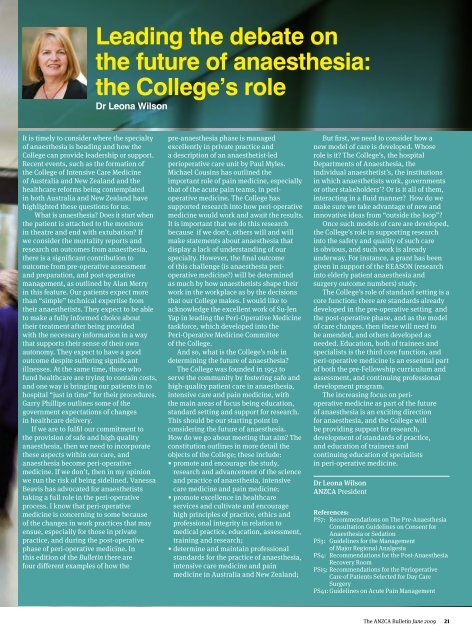ANZCA Bulletin - June 2009 - Australian and New Zealand College ...
ANZCA Bulletin - June 2009 - Australian and New Zealand College ...
ANZCA Bulletin - June 2009 - Australian and New Zealand College ...
- No tags were found...
You also want an ePaper? Increase the reach of your titles
YUMPU automatically turns print PDFs into web optimized ePapers that Google loves.
Leading the debate onthe future of anaesthesia:the <strong>College</strong>’s roleDr Leona WilsonIt is timely to consider where the specialtyof anaesthesia is heading <strong>and</strong> how the<strong>College</strong> can provide leadership or support.Recent events, such as the formation ofthe <strong>College</strong> of Intensive Care Medicineof Australia <strong>and</strong> <strong>New</strong> Zeal<strong>and</strong> <strong>and</strong> thehealthcare reforms being contemplatedin both Australia <strong>and</strong> <strong>New</strong> Zeal<strong>and</strong> havehighlighted these questions for us.What is anaesthesia? Does it start whenthe patient is attached to the monitorsin theatre <strong>and</strong> end with extubation? Ifwe consider the mortality reports <strong>and</strong>research on outcomes from anaesthesia,there is a significant contribution tooutcome from pre-operative assessment<strong>and</strong> preparation, <strong>and</strong> post-operativemanagement, as outlined by Alan Merryin this feature. Our patients expect morethan “simple” technical expertise fromtheir anaesthetists. They expect to be ableto make a fully informed choice abouttheir treatment after being providedwith the necessary information in a waythat supports their sense of their ownautonomy. They expect to have a goodoutcome despite suffering significantillnesses. At the same time, those whofund healthcare are trying to contain costs,<strong>and</strong> one way is bringing our patients in tohospital “just in time” for their procedures.Garry Phillips outlines some of thegovernment expectations of changesin healthcare delivery.If we are to fulfil our commitment tothe provision of safe <strong>and</strong> high qualityanaesthesia, then we need to incorporatethese aspects within our care, <strong>and</strong>anaesthesia become peri-operativemedicine. If we don’t, then in my opinionwe run the risk of being sidelined. VanessaBeavis has advocated for anaesthetiststaking a full role in the peri-operativeprocess. I know that peri-operativemedicine is concerning to some becauseof the changes in work practices that mayensue, especially for those in privatepractice, <strong>and</strong> during the post-operativephase of peri-operative medicine. Inthis edition of the <strong>Bulletin</strong> there arefour different examples of how thepre-anaesthesia phase is managedexcellently in private practice <strong>and</strong>a description of an anaesthetist-ledperioperative care unit by Paul Myles.Michael Cousins has outlined theimportant role of pain medicine, especiallythat of the acute pain teams, in perioperativemedicine. The <strong>College</strong> hassupported research into how peri-operativemedicine would work <strong>and</strong> await the results.It is important that we do this researchbecause if we don’t, others will <strong>and</strong> willmake statements about anaesthesia thatdisplay a lack of underst<strong>and</strong>ing of ourspecialty. However, the final outcomeof this challenge (is anaesthesia perioperativemedicine?) will be determinedas much by how anaesthetists shape theirwork in the workplace as by the decisionsthat our <strong>College</strong> makes. I would like toacknowledge the excellent work of Su-JenYap in leading the Peri-Operative Medicinetaskforce, which developed into thePeri-Operative Medicine Committeeof the <strong>College</strong>.And so, what is the <strong>College</strong>’s role indetermining the future of anaesthesia?The <strong>College</strong> was founded in 1952 toserve the community by fostering safe <strong>and</strong>high-quality patient care in anaesthesia,intensive care <strong>and</strong> pain medicine, withthe main areas of focus being education,st<strong>and</strong>ard setting <strong>and</strong> support for research.This should be our starting point inconsidering the future of anaesthesia.How do we go about meeting that aim? Theconstitution outlines in more detail theobjects of the <strong>College</strong>; these include:• promote <strong>and</strong> encourage the study,research <strong>and</strong> advancement of the science<strong>and</strong> practice of anaesthesia, intensivecare medicine <strong>and</strong> pain medicine;• promote excellence in healthcareservices <strong>and</strong> cultivate <strong>and</strong> encouragehigh principles of practice, ethics <strong>and</strong>professional integrity in relation tomedical practice, education, assessment,training <strong>and</strong> research;• determine <strong>and</strong> maintain professionalst<strong>and</strong>ards for the practice of anaesthesia,intensive care medicine <strong>and</strong> painmedicine in Australia <strong>and</strong> <strong>New</strong> Zeal<strong>and</strong>;But first, we need to consider how anew model of care is developed. Whoserole is it? The <strong>College</strong>’s, the hospitalDepartments of Anaesthesia, theindividual anaesthetist’s, the institutionsin which anaesthetists work, governmentsor other stakeholders’? Or is it all of them,interacting in a fluid manner? How do wemake sure we take advantage of new <strong>and</strong>innovative ideas from “outside the loop”?Once such models of care are developed,the <strong>College</strong>’s role in supporting researchinto the safety <strong>and</strong> quality of such careis obvious, <strong>and</strong> such work is alreadyunderway. For instance, a grant has beengiven in support of the REASON (researchinto elderly patient anaesthesia <strong>and</strong>surgery outcome numbers) study.The <strong>College</strong>’s role of st<strong>and</strong>ard setting is acore function: there are st<strong>and</strong>ards alreadydeveloped in the pre-operative setting <strong>and</strong>the post-operative phase, <strong>and</strong> as the modelof care changes, then these will need tobe amended, <strong>and</strong> others developed asneeded. Education, both of trainees <strong>and</strong>specialists is the third core function, <strong>and</strong>peri-operative medicine is an essential partof both the pre-Fellowship curriculum <strong>and</strong>assessment, <strong>and</strong> continuing professionaldevelopment program.The increasing focus on perioperativemedicine as part of the futureof anaesthesia is an exciting directionfor anaesthesia, <strong>and</strong> the <strong>College</strong> willbe providing support for research,development of st<strong>and</strong>ards of practice,<strong>and</strong> education of trainees <strong>and</strong>continuing education of specialistsin peri-operative medicine.Dr Leona Wilson<strong>ANZCA</strong> PresidentReferences:PS7: Recommendations on The Pre-AnaesthesiaConsultation Guidelines on Consent forAnaesthesia or SedationPS3: Guidelines for the Managementof Major Regional AnalgesiaPS4: Recommendations for the Post-AnaesthesiaRecovery RoomPS15: Recommendations for the PerioperativeCare of Patients Selected for Day CareSurgeryPS41: Guidelines on Acute Pain ManagementThe <strong>ANZCA</strong> <strong>Bulletin</strong> <strong>June</strong> <strong>2009</strong> 21
















